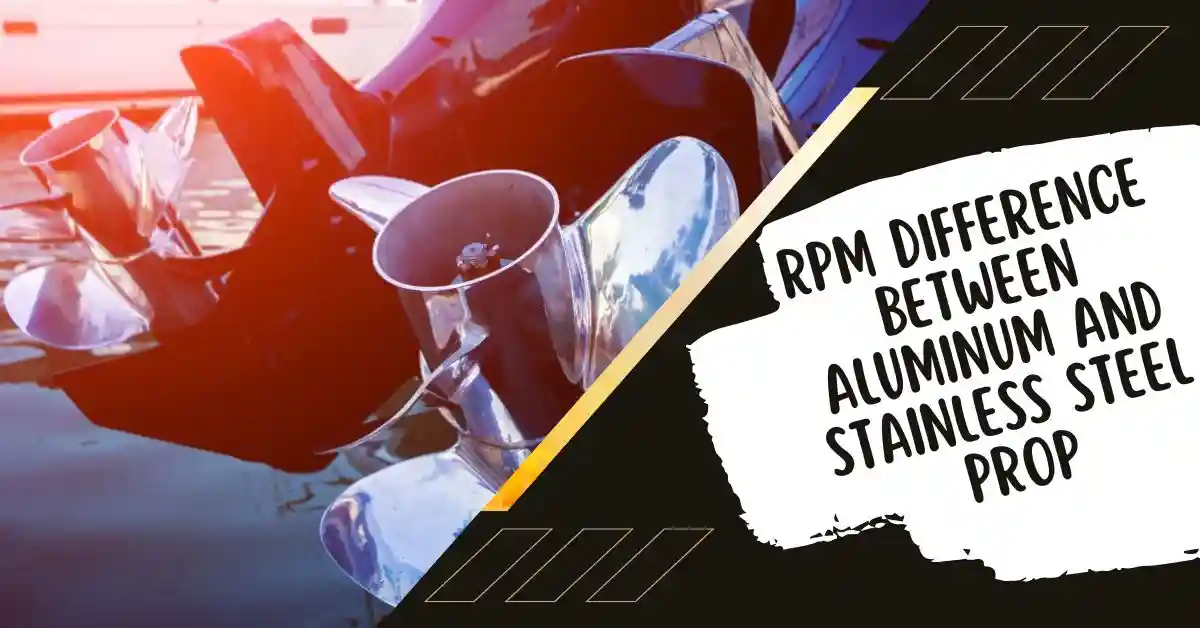You’re looking to increase your boat performance. Which could be due to a variety of reasons. And naturally you’re looking to up the rpm of your props. I completely empathize with you if you’re perplexed.
The rpm difference between the two types of prop material is, in fact, confusing.
So, What’s the rpm difference between aluminum and stainless steel prop?
The rpm difference between aluminum and stainless steel prop is that SS prop has lower rpm. But the rpm is mainly determined by the engine WOT. Along with other factors, pitch and diameter will impact the rpm of the prop. A SS prop with the same pitch as aluminum prop will give you higher top speed.
With the gist, you know that the rpm isn’t the only deciding factor for choosing props. We’ll discuss more in this article.
Let’s roll..
Table of Contents
ToggleRPM Difference Between Aluminum and Stainless Steel Prop
Previously we summarized the matter that rpm is actually determined by the engine’s WOT.
Hence, there’s no fixed number to differentiate the rpm difference between aluminum and stainless steel prop.
For the top speed of a boat, RPM matters. But several factors also influence the RPM of a prop.
Also, to get a maximum rpm, the prop has to match with the engine power. If you’re using a small prop with a high HP engine. It’ll be difficult to get a high rpm and top speed.
If you don’t do so, your outboard will run rough at a low speed.
Factors that Influence the RPM of a Prop
Here are the factors you should look into to figure out the correct rpm you need –
- Diameter of the Prop
- Pitch of The Prop
- Engine Type
Let’s talk about it in detail in the next sections.
Diameter of the Prop
The distance in inches across the circle made by the blade tips is the diameter. You’ll find out the diameter by measuring the distance as the blade rotates.
Diameters can affect the performance of the boat, the acceleration, the rpm and top speed. The larger the diameter, lower the rpm. But large diameter props help stay afloat in rough seas.
The choice of diameter of the prop depends on –
- Weight of the boat
- Mounting height
- Performance expectations
Small diameter propellers are linked to low weight boats. Those with low engine mounting height. Or if you’re looking at high performance race boats or heavier weight boats. Then you should look to buy a large diameter propeller.
The boat won’t go over 2000 rpm if there’s a smaller prop with a heavy boat.
Pitch of the Prop

Pitch is the inches of distance the prop moves forward in each 360 degrees revolution.
The number of inches the prop moves through the water in one revolution is called pitch. It increases proportionally to the steepness of the blades. And pitch effects rpm level.
Here’s a table to show you the differences between high pitch and low pitch
| High Pitch Prop | Low Pitch Prop |
| Lower RPMs | Higher RPMs |
| Higher Top End Speed | Improved Hole Shot |
With a high pitch prop, you generally have reduced rpm with higher top speed. Meaning, it’s slightly more difficult to rotate yet gives you increased speed at the end. Much like bikes that are hard to pedal. It will make your boat faster.
With a low pitched propeller, you have increased RPMs and improved hole shots. Means at the end, it won’t give you increased speed despite the high RPMs.
Hole shot is the time it takes to go to a wide open throttle from a neutral position.
The primary rule to measuring pitch is –
Higher the pitch, faster the top end speed and lower the revolutions. The acceleration is inversely proportional to the pitch and the higher the revolutions.
Engine Types

The smaller horse powered engine will give you lower power to rotate the propeller. Hence you’ll see lower RPM of the propeller. In contrast, a high powered engine will give a high maximum RPM.
And you’ll have to match the pitch and diameter accordingly to reach high rpms.
The RPM of a boat is set by the manufacturer. So the higher the pitch of your prop, the more top speed you get.
Now, there are two types of prop – Aluminum and Stainless Steel. Let’s see how they differentiate.
Aluminum Prop vs Stainless Steel Prop
Take a look at the table to compare the two types of props –
| Factors | Aluminum Prop | Stainless Steel prop |
| Cost | Inexpensive | Expensive |
| Flexibility | Flex under power | Less flex under power |
| Material | light | heavy |
| Damage | Low damage when hit | Can affect the engine when hit |
| Speed | Lower Top End Speed | Higher Top End Speed |
| RPM | Higher RPM | Lower RPM |
Cost
Due to the material of the aluminum prop, it’s cheap and light to manufacture.
On the other hand, SS prop tend to be more expensive
The cost also depends on the pitch, diameter and blade counts. While Aluminum props have 3 or 4 blades, SS props have 3 to 5 blades.
Flexibility
Being a light material, Aluminum prop flex under power. They are a little easier for the engine to push.
On the contrary, stainless steel props are heavy so they flex less under power. It’s a little hard for the engine to turn the SS prop. But they have faster acceleration with the same pitch as an aluminum prop.
Damage
When you hit something hard under the water with an aluminum prop, they sustain less damage. They will shear or bend, but the shock will not transfer to the other components. You may need to replace the prop, but it won’t damage your engine.
SS prop being a tough material, sustains more damage. Because as it hits something hard, it will transfer the shock to the engine. Which ultimately damages your boat. But physically, SS prop will look unharmed. So be aware.
Speed and RPM

With an aluminum prop, you’ll get a lower top end speed with each revolution. Because they don’t have as much cup in the blade, so they don’t hold in tight turns.
A SS prop will have higher top end speed with each revolution. hence , lower rpm yet higher speed. With the thin blades and tough material, SS prop will hold well in tight turns.
Final Verdict
So which prop gives you more rpm?
Well, Aluminum prop definitely gives you more revolution per minute with the same power. But it doesn’t give you higher top end speed. And you get increased acceleration.
Yet, SS prop will give you higher top end speed with lower revolution. And it holds well in deep, rough water.
So, the choice boils down to your requirements from a prop.
FAQs
Will A Stainless Steel Prop Increase Speed?
Yes, it can increase speed. If you are currently using an aluminum prop, change it to a stainless steel one. Even a simple stainless steel prop can typically increase peak speed. The narrower blades of a stainless prop can reduce drag in the water. Because stainless steel is stronger than aluminum.
What Prop Is Best For Speed?
It’s about performance and strength. Stainless steel propellers are more than five times more durable than aluminum propellers. Which are often quite affordable to buy and replace. A stainless steel propeller is worth considering for improved acceleration, top speed, or all-around performance.
Does Prop Diameter Affect RPM?
The two dimensions of a prop have different effects on performance. Every inch of pitch causes the RPM to vary by roughly 150 to 200 RPM. And every inch of change in prop diameter causes a shift of about 500 RPM (up or down). Bigger the diameter, the rpm will increase accordingly.
Can you switch between aluminum and stainless steel propellers on the same boat?
Yes, you can switch between aluminum and stainless steel propellers on the same boat. However, you should choose a propeller that is suitable for your boat’s weight, engine type, and performance expectations. The propeller’s diameter and pitch should also match the engine’s WOT to get maximum RPM and top speed.
Can propeller damage affect boat performance?
Yes, propeller damage can affect boat performance.
When a propeller hits a hard object, it can sustain damage that can affect the engine’s performance.
If the propeller blades are bent, the boat may have a rough ride, lower top speed, and decreased acceleration.
It’s essential to inspect the propeller regularly and replace it if it’s damaged.
Can the number of blades on a propeller affect boat performance?
Yes, the number of blades on a propeller can affect boat performance. A propeller with more blades will provide better low-speed handling, increased thrust, and improved acceleration.
However, it may have a lower top speed than a propeller with fewer blades.
The choice of the propeller depends on the boat’s weight, engine type, and performance expectations.
How often should I replace my boat propeller?
You should replace your boat propeller if it’s damaged or has worn-out blades.
The frequency of replacement depends on how often you use your boat and the water conditions.
It’s essential to inspect the propeller regularly for any signs of damage and replace it if necessary.
What is cavitation, and how does it affect boat performance?
Cavitation is a phenomenon that occurs when the pressure on one side of the propeller blade is low enough to create a vapor bubble.
This bubble then collapses, causing tiny explosions that can damage the propeller.
Cavitation can also decrease boat performance by reducing thrust and causing vibration. It’s essential to choose the right propeller to avoid cavitation and maintain your boat’s performance.
Can a propeller affect fuel consumption?
Yes, a propeller can affect fuel consumption. A propeller that’s too small or has a high pitch can cause the engine to work harder, resulting in higher fuel consumption. A propeller that’s too large or has a low pitch can also decrease fuel efficiency by causing the engine to run at a lower RPM. It’s important to choose a propeller that’s suitable for your boat’s weight, engine type, and performance expectations to optimize fuel consumption.
How can I determine the right propeller for my boat?
To determine the right propeller for your boat, you should consider several factors, including the boat’s weight, engine type, and performance expectations. You should also measure the propeller’s diameter and pitch to ensure that they match the engine’s WOT. It’s best to consult with a boat propeller specialist who can recommend the best propeller for your specific needs.
Conclusion
Hope we could answer your query to RPM difference between aluminum And stainless steel prop.
Now you know, rpm isn’t the only thing to consider if you want more speed. The engine matters, the water matters. This should help you to decide which prop is better for you.
Have a great day!
I’m Liam Jackson, the proud owner and driving force behind KayakPaddling.net. Born somewhere in the expansive beauty of the United States, I’ve nurtured a lifelong passion for kayaking and fishing that has led me to explore the far corners of our nation’s waterways.
Related Posts:
- 16 Best Kayak For Beginners 2024 - Kayaking Adventure Gear
- Heavy Duty Fishing: 11 Best Rods And Reels For Big Fish 2024
- 12 Best Beach Wagons & Carts 2024 - For All-Terrain
- 20 Best Inshore Spinning Reels 2024 - Capturing All…
- 16 Best Kayak Fishing Paddles 2024 - Affordable Fishing Gear
- 10 Best Fish Finders Under $200 2024 - Top Affordable Picks












